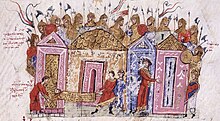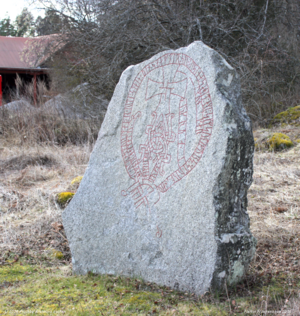Greece rune stones
Greece rune stones ( Swedish Greklandsstenarna ) are rune stones on which Varangians are mentioned, who were in the Byzantine Empire . The inscriptions date back to around 1100.
Over 130 rune stones are divided into seven groups according to the distinctive words used: England (30), Greece (30), Hakon-Jarl rune stones (3), Ingvar stones (26), Italy rune stones (4), Baltic Sea rune stones ( Regarding the Baltic States and Finland - 14 stones) and about 30 Varangian rune stones ( concerning Russia , Belarus , the Ukraine and neighboring areas), of which there are also copies in Denmark and Norway.
Historical background
In 988 Prince Vladimir the Great moved from Kiev with 6,000 Varangians on a campaign to the Byzantine Empire . Many of them stayed in Constantinople as the bodyguard of Emperor Basil II . In 1044 King Harald III moved. from Norway again with many Varangians. Some of them returned richly laden.
Often the Varangians did not return from the Byzantine Empire. Most of the inscriptions mention such persons. Only a small number of stones indicate people who returned to Scandinavia. Only one stone was donated by a returnee from Greece ( rune block by Ed ).
Designations
The Old Norse names for the Byzantine Empire and its inhabitants were
- Grikkland Greece
- Grikk (j) ar Greek
- Grikkfari Greece driver
- Grikkhafnir
Rune stones
Clickable map of the Greek rune stones in southern Sweden with modern administrative boundaries and selected cities |
30 rune stones are known so far, exclusively in Sweden. The inscriptions are in Old Norse , written in late Futhark runes.
The rune stones are:
- G 216 Timans on Gotland
- Ög 81 runestone from Högby
- LC 94
- Sm 46
- Sö 82
- Sö 163
- Sö 165
- Sö 170
- Sö 345
- Sö Fv 1954; 20
- U 73 rune stones from Hansta
- U 104 rune stone by Ed
- U 112 rune block by Ed
- U 136 Runestone from Broby bro
- U 140 Runestone from Broby bro also one of the Jarlabankestenarna
- U 201 rune stone from Angarn
- U 270
- U 358
- U 374 Runestone from Örby
- U 431 runestone from Norrsunda
- U 446
- U 518 rune stone from Västra Ledinge
- U 540 rune stones at the Husby Sjuhundra church
- U 792
- U 922
- U 956
- U 1016 from Fjuckby Arentuna
- U 1087
- Vg 178
The letters denote the regions in Sweden: Sö - Södermanland, U -Uppland etc.
Web links
- Rundata : Database of approx. 3600 runic inscriptions in Northern Europe. Rundata 2.5 Samnordisk runtextdatabas Institutions for Nordiska Språk, Uppsala Universitet
literature
- Signe Horne Fuglesang: Swedish Runestones of the Eleventh Century: Ornament and Dating. In: Klaus Düwel , Sean Nowak (Ed.): Runic inscriptions as sources of interdisciplinary research (= supplementary volumes to the Reallexikon der Germanischen Altertumskunde . Vol. 15). Walter de Gruyter, Berlin et al. 1998, ISBN 3-11-015455-2 , pp. 197-208 .
- Birgit Sawyer: The Viking Age Rune Stones. Custom and Commemoration in Early Medieval Scandinavia. Oxford University Press, Oxford et al. 2000, ISBN 0-19-926221-7 .
See also
Remarks
- ^ Judith Jesch: Ships and Men in the Late Viking Age. The Vocabulary of Runic Inscriptions and Skaldic Verse. Boydell Press, Woodbridge 2001, ISBN 0-85115-826-9 .
- ↑ U 112, U 374, U 540
- ↑ all others
- ↑ U 270, U 956
- ^ U 1016
- ↑ Rundata, All Nordic database for rune stones
- ↑ in Nolinge near Stockholm, discovered in 1952



